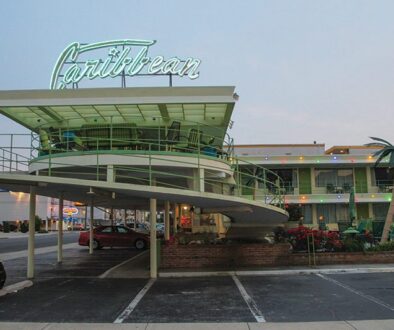Remembering Forgotten Warriors

In January of 2016, winter storm Jonas hit southern New Jersey, leaving a mark that rivaled the famous nor’easter of 1962. American Legion Post 184, part of the VFW building located on Pacific Avenue in Wildwood, set up a relief center for the community. Thirty tables were filled with food, clothing, and essentials. The relief effort was organized by various veterans’ organizations: The VFW, American Legion, and the local chapter of the Vietnam Veterans of America. These groups are comprised of men and women who served the United States Armed Forces throughout the world. Today they continue that service as civilians in Cape May County.
Cape May is a pretty patriotic place—you don’t have to look far to see an American flag flying in the ocean breeze. You also don’t need to look far to find memorials, monuments, and museums that honor those veterans who continue to do so much to support the place they call home. According to Gerald Thornton, Director of the Board of Freeholders, Cape May County was the first in the state of New Jersey to have a Veteran’s Bureau. As a Vietnam veteran himself, Thornton oversees the bureau. Several years ago, he was involved in securing a place for the Forgotten Warriors Vietnam Veterans Museum, located across from the Naval Aviation Museum at the Cape May Airport in Rio Grande.
The idea began with a Vietnam vet named Thomas Collins. He was looking for a place to display memorabilia from the Vietnam War, in the hopes of educating the public and the next generation about the 20-year conflict. The name is fitting, considering the fact that Vietnam was one of the most controversial conflicts in American history. Many vets coming home from Vietnam were not honored with ticker tape parades; on the contrary, most faced opposition and ridicule, and as a result preferred to fade into the background.
“I can tell you this first hand, Thornton recalls. “I know because I experienced that. Being in uniform during the Vietnam War I can tell you that people looked down on us when in our uniform very often and it was shameful.”
When Collins wanted to create a space to memorialize the forgotten, the county helped secure the land. Previously the space was home to a senior citizen center that was torn down. The museum operates from donations alone, and Collins supports and curates the space himself. The project began in a small shed, and found a larger home with the help of the county. According to Thornton, the county arranged for the property to be leased to Collins for one dollar per year, and assisted with grant funding. County resources were used to move some equipment and army vehicles onto the property. Thornton attributes its success to its founder. “Tom Collins is a really good guy, and this was really his project.”
The small building is located at the end of a gravel road, and lies in the shadow of the large airplane hangar. The building itself is as unassuming as its founder, but commands a presence due in part to the army vehicles, river boat, and old helicopters that flank the entrance. A small memorial with the names of the veterans from Cape May County who died during Vietnam lies beneath a flag pole. Inside holds hundreds of artifacts from the war. Larger items were donated by the federal government; however most of the items, such as casket flags, pictures, and personal items, were provided by the veterans themselves.
The outpouring of memorabilia in a short period of time caused that space to fill up quickly. “The property outgrew itself,” notes William Davenport, a member of the Michael P. Callahan Memorial Chapter 955, of the Vietnam Veterans of America. Davenport served in 1967 and donated his winter uniform. The future and growth of the Museum may rely on support from the citizens of Cape May County, and could potentially receive more help from the local government.
With regard to assisting in securing more space for the Forgotten Warriors Museum, Gerald Thornton stressed that the county would help in any way necessary. “I would make that recommendation to the board and we would try and go out of our way to accommodate Tom Collins and the Vietnam Veterans museum. I know that first hand in my heart and I know my colleagues will support me on the board of Freeholders. All they have to do is make the request.”
“[Collins] just wants to educate the public and let them be exposed to it,” notes Davenport, who knows a thing or two about county projects that memorialize Vietnam. A Wildwood native, Davenport was part of the organizations that brought the Vietnam Memorial Wall to fruition in his hometown. In 2008, a travelling replica of the Wall in Washington D.C. was brought to Wildwood. For about a week, temporary walls are set up in towns throughout the United States that bear the names of all the men and women who were lost during the conflict. For about five days, this temporary wall found a home in Wildwood’s Fox Park. The impact was evident: the wall’s presence helped to educate and inform visitors of the ultimate sacrifices that were made by the men and women who served during the Vietnam War. Local Veterans organizations and the Vietnam Veterans of America held opening and closing ceremonies to commemorate its visit to Wildwood. The president of the local chapter at the time was a gentleman named Greg Mazzotta.
“At the closing ceremony we all get on stage and we all had little talks, and [Mazzotta] says we’re going to get a permanent wall here in Wildwood. Well, he didn’t tell any of the members that.” Davenport says, laughing.

Mazzotta passed away two months later, in his early 60s. In the wake of his death, the men that were gathered at the temporary wall that day were determined to make his dream a reality. They looked into purchasing temporary walls that are eventually retired, but the materials are made of aluminum, which would not withstand the seashore environment. So they began a fundraising effort to create a wall of granite and concrete exactly like the one in Washington (except that it’s half the size). They broke ground in October of 2009, expecting the project to take three years to secure more than $100,000 to complete it. After an outpouring of support from the community and donations in the form of service, labor, and money, the wall was completed several months later and dedicated on Memorial Day of 2010.
Wildwood Mayor Ernie Troiono enlisted his own company as a general contractor and concrete supplier. Vince Deprinzio, Mazzotta’s cousin and fellow Vietnam Veteran, was instrumental in rallying organizations in the area to build the wall, which has been open to the public for the past six years. It resides in Columbus Park, across from the Wildwood Convention Center. It took about two months to build, and measures two hundred and fifty feet in length and five feet, five inches high. It is estimated that about one hundred thousand people come to visit the wall every year. Some venture to Wildwood for the sole purpose of finding the name of a loved one or friend, and a computer system there and online phone applications assist in finding a name. Davenport notes that the vets were not completely pleased with the idea of the wall being a tourist attraction, however, “We realized the more people could see it, the more people could become educated about the war.”
Today, during block parties, special events, and ceremonies, the Vietnam Vets Chapter and other organizations stand by the wall to help people find a name, talk about the war, and educate anyone who may be interested. “We get a lot of people at night,” Davenport says. It is a quiet place to pay tribute, and to remember friends. For many veterans who for so many years refused to talk about the time that they served, it has become a place for them to tell their story.
On a rainy Memorial Day, a group gathered in the same room at the VFW that served as a place of relief during Winter Storm Jonas five months earlier. A woman takes to the podium to tell the story of her own experience with a Vietnam Veteran. “Let me tell you about my brother Stanley.”
Marie Hayes of the Cape May County Board of Chosen Freeholders spoke of her brother, a vet whose service began in 1969. She recalled the day he came home from Vietnam.
“At the end of his tour my brother David and I went to the bus station to pick up my brother Stanley. In full uniform we saw him walking down the street,” she recalls. “We began to honk the horn, and I’m waving and I’m screaming and as I ran up to my brother a car rode by screaming and waving. I thought they were paying tribute to my brother, but I soon realized what they were screaming and it was not a tribute. And the wave that they had done was with one finger. My brother asked me at that time never to make a fuss over him being a soldier ever again.”
Hayes’ brother served two back-to-back tours in Vietnam, and upon his return, besides ridicule, faced various emotional and physical ailments. He passed away in his early forties, from lung cancer that spread to his brain. His story is not unique.
“There’s 59,000 who died during the war, and they estimate close to a million have died since the war. When you put that in perspective with respect to age, I mean most are dying in their 40s, 50s, and 60s, and that’s just entirely too early,” Bill Davenport says, as he recalls losing fifteen members of Chapter 955 in an eight-year period.
In 1980, a Veteran’s cemetery was opened on Crest Haven road at the county complex, a project that was created and spearheaded by Gerald Thornton. “We have approximately 6,800 graves there, 5,400 that are filled. And we’re looking for more space. I think when the new jail is constructed and we take down the old jail, we’re going to convert that into more cemetery space, so that will probably take us for another 50, 60, 70 years of space. And hope that we don’t have any more wars that we have to fill that cemetery up with more veterans.”
“A lot of veterans are in poor physical and medical conditions. There are 22 suicides a day of veterans.” Davenport says, stressing the importance of organizations that work to provide vets with a support system for both mental and physical conditions. However the American Legion, VFW, and Vietnam Veterans are centered around community events and providing services for the greater good of the communities they inhabit. While run by veterans, their focus is on working within the community for veterans and civilians alike. Which is how the VFW came to be home base for the relief effort during Jonas back in January.
Despite the ridicule, the illnesses, and the post-traumatic stress, the veterans of Cape May County have in many ways never ceased to serve. Clearly, Cape May has a lot to be proud of: it’s the first county with a veterans bureau. It’s a place where an entire city operates as a National Historical Landmark, a place that is built on memorials and remembering our history. It’s a place that is home to forgotten warriors who served the rest of us. The cemetery on Crest Haven Road will inevitably one day be filled. Once it is, how will we ensure that those who were once forgotten will always be remembered?



